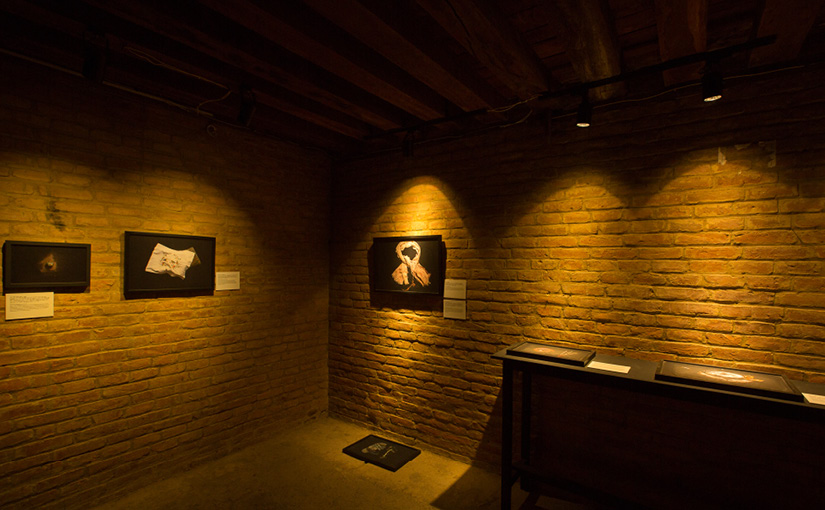by Yukta Bajracharya
“War photographers or journalists go to the war affected areas to cover the conflict, the war. But once the war is over, the memories of war aren’t shared. The people who experienced the war or even those who didn’t experience the war directly, might have memories to talk about. I was born just 3 years after the war and survivors still shared their painful experiences. Just because the war is over, it does not mean that country is back in peace. It takes decades for a war-stricken country. People have been psychologically affected. This project is my way of talking about the memories of war,” says Cambodian photographer Kim Hak.
Walking through ‘Alive’ an exhibition of photos by Hak, at Eba Bahi in Tangal, is a walk through down the memory lane of the survivors of the Khmer Rouge regime. Some of the stories that Hak has unearthed were memories that families never spoke about before.Through a photographic series of objects that belonged to individuals and families, Hak brings out personal stories from this brutal regime and keeps those memories alive.
Below is an excerpt from an interview with Hak.
You started the project with objects and memories from your own family.
I first started with the memories of my own families and a few objects that we had.
When in 1975, the Khmer Rouge arrived, many people had to throw away their old photos and ID cards in order to hide their previous background. If the Khmer Rouge found out who they were, especially if they were educated people, they would have been killed. My father was one of the educated people. He also worked as a government officer. So my mum threw away a lot of old photos but also took a big risk to keep some photos so to remember family members and old friends. My mum wrapped those photos in plastic and buried some under the ground for four years. I didn’t know about this until I started this project in 2014. And my mum showed me the location where she had buried those photos only earlier this year. I realized that memories such as these were important parts of history.
It has been over forty years since the Khmer Rouge took power and the people who experienced it are getting old and dying. If these people pass away, and we don’t record these memories, they will be lost.
I have also extended this project to families of my close friends. The exhibition I am showing includes objects from four families in Cambodia and a few from Cambodian Australians. This is an ongoing project. While working on the series, I began questioning about the survivors of Khmer Rouge who left for other countries. What objects did they take along? Last year I worked with Cambodian Australians. End of this year, I am going to France to work with Cambodian French there and next year perhaps with Cambodian Americans. Once all the materials are collected, I want to create a photobook.
Was there something in particular, any object or moment or incident, that inspired this series?
One object that led me to these memories is the kettle that belongs to my family. For 35 years of my life, I have always seen this kettle. The kettle is very old and broken but my first sister kept repairing and using it to boil water even when there were other new kettles. So I started to question my sister and mother about why the kettle was so important.
During the war, we didn’t have any privacy. Even when we raised chickens, we couldn’t eat them. Sometimes my mum would catch a chicken at night and boil it in the kettle. One day my father was sick and very weak so she caught a chicken and gave it to him. But my father was afraid of getting killed and he didn’t dare to eat it. Today, this has become a joke my mother uses on my father.
What is something that you keep in mind when making these photographs?
First, it’s the object. Second, the memory attached to the object. Before I start shooting the photos, I have casual conversations with the owners of the objects. Then I go back to the owners to record these stories. I listen to these stories many times and take some time to think over it. I pick out clues that connect the object to the memory and then photograph them.
I don’t choose objects for their charm or beauty. I make sure that the objects are the ones that stayed with the owners through all these years.
Also, I chose a black background to photograph these objects. This is not only to make the objects stand out but also to signify the dark history of the Khmer Rouge itself.
What has been the reaction from people back home when you exhibited this work there?
I have showed this exhibition in two different cities in Cambodia and also in a couple of places outside Cambodia. After the exhibitions, people started talking about my work. A Cambodian Australian called and told me that his mother also shared a similar story of the kettle and chicken. Another Cambodian living in New Zealand called to tell me that his family also wrapped photos in plastic and buried them. Through these images, common memories of many families have emerged and they have started talking about them.

